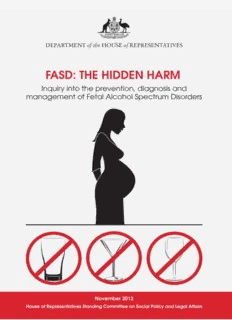
Fetal Alcohol Spectrum Disorders - Parliament of Australia PDF
Preview Fetal Alcohol Spectrum Disorders - Parliament of Australia
The Parliament of the Commonwealth of Australia FASD: The Hidden Harm Inquiry into the prevention, diagnosis and management of Fetal Alcohol Spectrum Disorders House of Representatives Standing Committee on Social Policy and Legal Affairs November 2012 Canberra © Commonwealth of Australia 2012 ISBN 978-0-642-79762-9 (Printed version) ISBN 978-0-642-79763-6 (HTML version) This work is licensed under the Creative Commons Attribution-NonCommercial- NoDerivs 3.0 Australia License. The details of this licence are available on the Creative Commons website: http://creativecommons.org/licenses/by-nc-nd/3.0/au/. Contents Foreword ............................................................................................................................................ vii Membership of the Committee ............................................................................................................ ix Terms of reference .............................................................................................................................. xi List of abbreviations and acronyms ................................................................................................... xiii List of recommendations .................................................................................................................. xvii THE REPORT 1 Introduction ........................................................................................................... 1 2 FASD and alcohol consumption patterns ......................................................... 11 What are Fetal Alcohol Spectrum Disorders? ...................................................................... 11 History ...................................................................................................................................... 13 The effect of alcohol on a fetus ............................................................................................. 14 Normal development ................................................................................................................. 15 Alcohol exposure ....................................................................................................................... 16 Impact on the fetal brain ............................................................................................................ 18 Effects at critical times of development ..................................................................................... 21 FASD symptoms ..................................................................................................................... 22 Secondary conditions ................................................................................................................ 29 FASD prevalence in Australia ................................................................................................ 31 FASD and Indigenous communities .......................................................................................... 33 Alcohol use in Australian society .......................................................................................... 35 Patterns of consumption ........................................................................................................... 36 Young people ............................................................................................................................ 38 iv Indigenous communities ........................................................................................................... 40 Pregnant women and alcohol consumption rates ............................................................... 41 Reasons pregnant women continue to consume alcohol .......................................................... 43 3 FASD awareness and prevention ...................................................................... 49 Prevention through education and support .......................................................................... 49 The role of health professionals ................................................................................................ 50 Raising public awareness ......................................................................................................... 55 Specialised intervention and support services .......................................................................... 64 Committee Comment ................................................................................................................ 66 Prevention through reforms of alcohol sales and labelling ................................................ 71 Pricing and availability ............................................................................................................... 72 Promotion .................................................................................................................................. 76 Labelling .................................................................................................................................... 78 Committee Comment ................................................................................................................ 86 4 Diagnosis ............................................................................................................. 91 Critical importance of early diagnosis and intervention ...................................................... 91 Obstacles to diagnosis ........................................................................................................... 95 Stigma ....................................................................................................................................... 96 Current capacity of health professionals to diagnose FASD ..................................................... 97 Complexity of FASD ................................................................................................................ 100 Nationally consistent diagnostic tool and guidelines ............................................................... 102 Lack of diagnostic services in Australia ................................................................................... 103 After the diagnosis ................................................................................................................ 106 Committee Comment ............................................................................................................ 110 5 Management needs ........................................................................................... 115 Lack of prevalence data to inform management ................................................................ 116 Carers ..................................................................................................................................... 117 Challenges .............................................................................................................................. 121 Actions .................................................................................................................................... 126 Education ............................................................................................................................... 129 Challenges .............................................................................................................................. 131 v Actions .................................................................................................................................... 134 Criminal Justice System ....................................................................................................... 136 Challenges .............................................................................................................................. 137 Actions .................................................................................................................................... 142 Identifying FASD as a disability ........................................................................................... 143 Committee Comment ............................................................................................................ 145 APPENDICES Appendix A – List of Submissions ......................................................................... 149 Appendix B – List of witnesses appearing at public hearings ............................ 153 Appendix C – List of exhibits .................................................................................. 161 vi Foreword Children are our hope distilled. At birth they are a launching pad for all of society’s dreams and aspirations. They personify humanity’s unlimited potential. Yet tragically, for too many babies in Australia, their opportunities and circumstances are severely diminished even before they draw their first breath. The harm caused by Fetal Alcohol Spectrum Disorders (FASD) is hidden in the damaged brain. It may masquerade as naughty behaviour, poor parenting, lack of discipline, or simple-mindedness. However, it is none of these things. FASD is an entirely preventable but incurable condition caused by a baby’s exposure to alcohol in the womb. The consequences are expressed along a spectrum of disabilities including: physical, cognitive, intellectual, learning, behavioural, social and executive functioning abnormalities and problems with communication, motor skills, attention and memory. While the risk of FASD increases with the quantity of alcohol a pregnant woman consumes, what is not widely understood is that even small amounts of alcohol, at critical times, can result in irrevocable damage to the developing fetus. In many cases, the damage is not physically apparent but can manifest itself in lifelong learning difficulties and cognitive impairment. Awareness of FASD is increasing in Australia, but much work needs to be done. The series of recommendations made by the Committee outline a national strategy to prevent, identify and manage FASD in Australia. This national strategy can spearhead progress in all sectors—health, education, criminal justice, social support—toward understanding, treating and most importantly eliminating FASD. viii The Committee is grateful for the unstinting work of individuals and organisations that have contributed to increasing awareness and knowledge of FASD and its prevalence in Australia and have lobbied for action, often without recognition or remuneration. These efforts have been the catalyst for this parliamentary inquiry and the actions that will follow. Time and again during the inquiry, the Committee heard about the devastation that can be caused by prenatal alcohol exposure. Foster carers spoke about children in their care and the enormous challenges they face. Paediatricians spoke about the lack of awareness and lack of diagnostic resources for FASD. Indigenous community leaders spoke about communities and culture in crisis due to FASD. Women spoke about the conflicting health messages given and the desperate need for clear advice from health professionals. Amidst all these voices, the most moving was that of Tristan, a young man affected by FASD. Tristan says: I wish I can be a policeman just when I grow up … Nah … I just want to be normal first. I just want to be normal. We owe it to Tristan, and to every child and every woman and every family in Australia, to bring to light the risk of FASD. We cannot keep hidden the devastating harms being caused by prenatal alcohol exposure. Mr Graham Perrett MP Chair Membership of the Committee Chair Mr Graham Perrett MP Deputy Chair Hon. Judi Moylan MP Members Mr Shayne Neumann MP Ms Michelle Rowland MP (to 07 February 2012) Ms Laura Smyth MP Hon. Dr Sharman Stone MP Mr Mike Symon MP (from 07 February 2012) Mr Ross Vasta MP
Description: